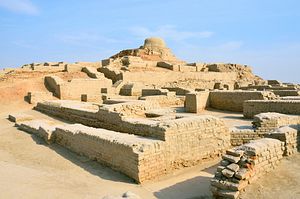A new paper published in the journal Nature on May 25 has firmly established that the antiquity of the Harappan or Indus Valley Civilization (IVC) and its predecessors goes back almost 8,000 years, with some signs of settlement dating back to over 9,500 years before the present.
The civilization, which arose in the Indus-Ghaggar-Hakra river system (the Ghaggar and Hakra rivers are now defunct), spread out over a large area of modern Pakistan, eastern Afghanistan, and northwestern India. It is now believed to have been a lot larger than previously assumed, as archaeologists initially believed that both the most important and largest of the Harappan sites dated from the third millennium BCE and were located on the Indus river and its tributaries in modern Pakistan. However, it is now established that the initial the original discoveries were merely the tip of an iceberg. Harappan sites were not only dated to thousands of years before the initial third millennium finds, but were found in widely dispersed locations. These include Balochistan, Helmand in Afghanistan, and in Maharashtra and Uttar Pradesh in India.
According to the paper in Nature, many of these early Harappan sites flourished on the Ghaggar-Hakra (mythical Saraswati) River, which flowed from the Himalayas through what is today the Thar Desert of Rajasthan in India into the Rann of Kutch in Gujarat; these areas contain low populations today. “More than 500 sites of Harappan settlements have been discovered in this belt during the last hundred years,” according to the paper. The paper focuses on one of these sites, Bhirrana, in today’s Haryana, India. The findings from Bhirrana are interesting and shed light on one of archaeology’s enduring questions.
It has always been a big mystery as to why such a widespread civilization suddenly collapsed, as it appears to have done in the second millennium BCE. Prior theories held that the collapse of the Harappan civilization coincided with similar collapses among the Akkadians in Mesopotamia, the Minoans in Crete, and a civilization in the Yangtze valley due to “either weakening of monsoon or pan-Asian aridification (drought events) at [2100 BCE].” However, the paper points out that there are many discrepancies between the climatic and historical events in question. While climate was a factor, it was not the direct cause of a civilizational collapse in South Asia.
The archaeology at Bhirrana reveals that the community, like the rest of the Harappan civilization, went through four phases, the first two of which “were represented by pastoral and early village farming communities.” The third phase, from 2,600-1,900 BCE represents the mature, urban phase of the civilization, while the fourth (1900-1300 BCE) phase is a phase of decline. During the mature phase, “Harappan settlements were highly urbanized with several organized cities, developed material and craft culture having trans-Asiatic trading to regions as distant as Arabia and Mesopotamia. The late Harappan phase witnessed large scale de-urbanization, population decrease, abandonment of many established settlements, lack of basic amenities, interpersonal violence and disappearance of Harappan script.”
According to discoveries described in the paper, the Harappan civilization didn’t collapse per se but de-urbanized. At Farmana, a site near Bhirrana, there is sharp decrease in the ubiquity of wheat and barley from the mature to the declining period. This represents a pattern where people adapted to changing monsoon patterns–something they chose not to do during previous droughts and climatic shifts. Perhaps, this time around, rice, introduced from East Asia, had become a widespread alternative crop. Thus, during the period between 1,900-1,300 BCE, Harappans “shifted their crop patterns from the large-grained cereals like wheat and barley… to drought-resistant species of small millets and rice in the later part of declining monsoon and thereby changed their subsistence strategy.”
The result was the transformation of society into a more widely dispersed, clan-centered culture. It should be noted that other rice-based cultures like China were also largely agrarian and rural while mercantile cities and city-states played a larger role in the wheat-producing regions of the Middle East and Mediterranean. This is because millet and rice “generally have much lower yield” than wheat. Thus, “the organized large storage system of mature Harappan period was abandoned giving rise to smaller more individual household based crop processing and storage system.”
By the time the next strata of literature emerges in India during the Vedic period, this form of social structure is evident. The famous Indus Valley Civilization thus never collapsed; its large structures were only expedient buildings reflecting a wheat-based culture. Once crop patterns shifted, most cities lost their purposes and were abandoned, but most people didn’t die out. Instead, they fanned out, south and east, shifting the demographics of the subcontinent toward the Gangetic Valley.

































